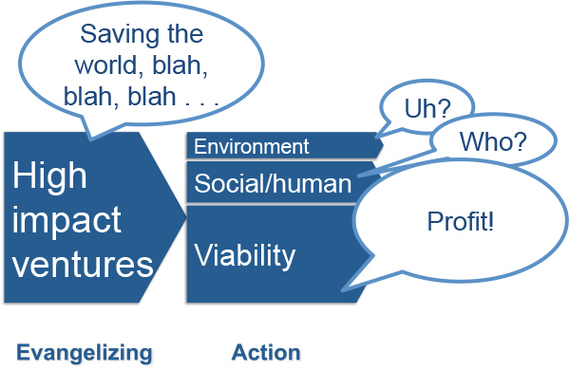Co-written by Dr. Ab Stevels
Startups tackling sustainability are now in vogue, with organic farming, clean energy and mediation platforms for the sharing-economy. Whether they are rooted in a sincere desire to improve our world or just interested in lip service remains to be seen. If the sustainability performance from established firms is any indicator - it will take a paradigm shift for any real change to occur.
Sustainable businesses that apply triple-bottom-line principles in accounting outperform their less sustainable competitors on all three metrics, Social/human, Environmental and Viability. However, studies at Stanford University show that even experienced product development organizations fail to properly integrate sustainability objectives in their design targets - largely leaving it up to chance to create new sustainable triple-bottom-line offerings.
Observing new high-impact ventures qualifying for investor pitching at the INDEX Award's Investor Day provided further insights into how designs by start-up companies performed from a sustainability perspective.
Comparing the assessment of the top one-percentile INDEX: Award high-impact ventures with that of more traditional startups researched in Los Angeles showed high-impact ventures outperforming conventional startups on all Design Quality Criteria. However, all high-impact award applicants as a group only did better on Structure, Innovation and Function, none of which are among the triple-bottom-line criteria.
The environmental dimension
When it came to the new ventures' claimed environmental performance, there was no correlation with any metrics - showing that environmental concerns for potential high-impacts, at best, can be expressed as lip service and happen more or less coincidentally.
The social/human dimension
When it came to the new ventures' social/human performance, there was a correlation with the offerings in all categories. This applies especially to 'Expression' (styling and aesthetics) and 'Combined Risk' (Market x Technology Risks x Execution Risk). There is also a positive correlation with the so-called investors' average Design Quality Criteria score (the Investor Design Index.)
The Design Index is the un-weighted average rating of nine Design Quality Criteria, divided into three categories: Strategy (Philosophy, Structure and Innovation), Context (Social/human, Environmental and Viability) and Execution (Process, Function and Expression). These have been derived from international design awards, as well as, design briefs and have shown to be strong lead indicators of online dissemination as well as, financial performance.
Altogether, this demonstrates that high impact in the social/human dimension is seen by startups to require special attention. Metrics show that, in particular, this applies to Expression (styling and aesthetics). In practice, this is very risky and requires a high level of design competencies, however, if done well, it is effective in increasing a venture's valuation.
The viability dimension
When it came to the new ventures' Viability performance, these correlated strongly with the offering's Philosophy, Structure, Process, and Function.
This shows that for a high score for the venture's economic performance (Viability), the ideas behind a new product (Philosophy), together with its fit within a supply chain Structure, its implementation (Execution) and its design quality are all considered essential elements.
Although the best high-impact startups scored better than regular startups, they still have substantial potential for improvement. As things stand now, environmental performance and better communication with the design teams seems to be essential in turning the present state-of-the-art sustainability of startups into real opportunities for business growth.
Special thanks to Dr. Ab Stevels for co-writing and researching this article
